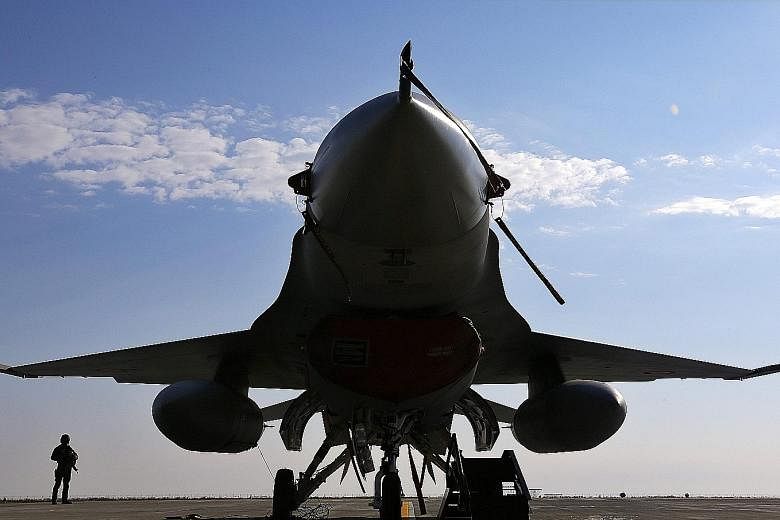Mr Jens Stoltenberg, the secretary-general of the North Atlantic Treaty Organisation (Nato), has acknowledged that the US-led military alliance is now engaged in its largest build-up in Europe since the days of the Cold War.
But although Mr Stoltenberg vowed that the movement of troops closer to the borders of Russia does not amount to a "new arms race", counter-manoeuvres by Russian forces indicate that this is precisely what is now unfolding in Europe. And Western military planners are bracing themselves for worse in the months to come.
Mr Stoltenberg was speaking on the eve of today's 50th-anniversary celebrations of the establishment of Nato's Defence College, the alliance's highest training centre, in Rome. Although his comments were couched in academic terms, they sought to address a series of security developments that is fast changing Europe's strategic map.
 An F-16 Fighting Falcon jet fighter at the 86th Air Force Base in Borcea, Romania. The Nato member plans to buy 12 used F-16 jets from Portugal. PHOTO: EUROPEAN PRESSPHOTO AGENCY
An F-16 Fighting Falcon jet fighter at the 86th Air Force Base in Borcea, Romania. The Nato member plans to buy 12 used F-16 jets from Portugal. PHOTO: EUROPEAN PRESSPHOTO AGENCY As Nato leaders see it, Russia unleashed the latest confrontation with its annexation of neighbouring Ukraine's Crimean peninsula in early 2014 and the subsequent help it gave Russian rebels in Ukraine. These moves alarmed the former communist countries of eastern Europe which are now Nato member states but which, due to history and their geographic location, continue to fear Russian intentions.
Largely at the behest of the eastern Europeans, Nato decided in July to permanently station three "enhanced forward presence" battalion-sized units, consisting of 300 to 800 soldiers each, on the territory of Estonia, Latvia and Lithuania, the three small Baltic republics in northern Europe which used to be part of the Soviet Union and which regained their independence only in the early 1990s. A further US unit of a similar size is currently deployed in neighbouring Poland.
While the numbers involved in these deployments remain modest, their strategic message is important. For these are the first semi-permanent deployments of Western troops deep inside the territory of what used to be considered a Soviet sphere of influence. And they are the harbingers of a much bigger realignment.
As part of a programme called the European Reassurance Initiative, US President Barack Obama has allocated US$3.4 billion (S$4.6 billion) during the next year to pre-positioning military equipment in the new Nato member states and creating additional units which can be deployed within days. Furthermore, US efforts are being buttressed by key European contributors. The British are leading the formation of a powerful rapid deployment brigade which can include up to 3,500 personnel. And for the first time since the dark days of World War II, German troops are to be garrisoned in Lithuania, in itself a remarkable European transformation.
Russia claims that all these moves violate agreements reached during the 1990s under which the West allegedly promised not to station troops in eastern Europe. As Russian Foreign Minister Sergei Lavrov put it earlier this week, the moves are seen in Moscow as "aggressive steps that really hurt our national interests and pose a threat to our security". And all the indications are that the Russians are now responding in kind.
Overflights by Russian military jets over Finland and Estonia - the latter is in Nato while the former is not - have become almost routine. Although these were usually performed by ageing and often unarmed Russian aircraft, the latest intrusions came from top-notch SU-27 jet fighters, fully armed for combat.
More significantly, the Russians have just confirmed Western intelligence reports that they have deployed their latest Iskander-M missiles to Kaliningrad, a sliver of Russian land sandwiched between Poland and Lithuania on the Baltic Sea. The Iskander-M system has a range of 480km, can carry either conventional or nuclear warheads and can strike targets deep within Poland and across the whole Baltic region. Its introduction amounts to a significant change in the regional strategic balance.
Mr Stoltenberg is anxious to tread a careful line. On the one hand, he has to respond to the Russian moves. On the other hand, he is also mindful of concerns from some western Europeans who argue that Nato should do nothing in order to break the cycle of tit-for-tat escalation and avoid a bigger confrontation.
Meanwhile, Nato is also getting no lead from the US, which remains distracted by its presidential election campaign. Mr Obama's officials have maintained complete silence on the latest Russian military deployment.
But few commanders at Nato's headquarters in Brussels doubt that the confrontation with Russia will continue, at least until a new US president arrives in the White House in January.


